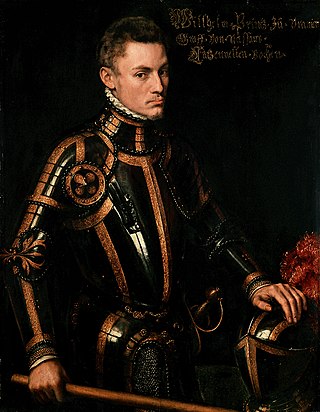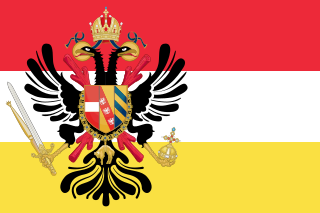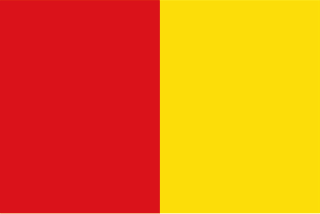
The United Kingdom of the Netherlands is the unofficial name given to the Kingdom of the Netherlands as it existed between 1815 and 1830. The United Netherlands was created in the aftermath of the Napoleonic Wars through the fusion of territories that had belonged to the former Dutch Republic, Austrian Netherlands, and Prince-Bishopric of Liège in order to form a buffer state between the major European powers. The polity was a constitutional monarchy, ruled by William I of the House of Orange-Nassau.

In the Low Countries, a stadtholder was a steward, first appointed as a medieval official and ultimately functioning as a national leader. The stadtholder was the replacement of the duke or count of a province during the Burgundian and Habsburg period.

The Seventeen Provinces were the Imperial states of the Habsburg Netherlands in the 16th century. They roughly covered the Low Countries, i.e., what is now the Netherlands, Belgium, Luxembourg, and most of the French departments of Nord and Pas-de-Calais (Artois). Also within this area were semi-independent fiefdoms, mainly ecclesiastical ones, such as Liège, Cambrai and Stavelot-Malmedy.

Limbourg or Limbourg-sur-Vesdre is a city and municipality of Wallonia located in the province of Liège, Belgium.

The Southern Netherlands, also called the Catholic Netherlands, were the parts of the Low Countries belonging to the Holy Roman Empire which were at first largely controlled by Habsburg Spain and later by the Austrian Habsburgs until occupied and annexed by Revolutionary France (1794–1815).

The Austrian Netherlands was the territory of the Burgundian Circle of the Holy Roman Empire between 1714 and 1797. The period began with the acquisition by the Austrian Habsburg monarchy of the former Spanish Netherlands under the Treaty of Rastatt in 1714. It lasted until Revolutionary France annexed the territory after the Battle of Sprimont in 1794 and the Peace of Basel in 1795. Austria relinquished its claim on the province in 1797 through the Treaty of Campo Formio.

Namur was a county of the Carolingian and later Holy Roman Empire in the Low Countries, a region in northwestern Europe. Its territories largely correspond with the present-day French-speaking Belgian arrondissement Namur together with the northwestern part of the arrondissement Dinant, which are both part of the modern province of Namur. The modern provincial boundaries are based on the French Republican department of Sambre-et-Meuse.

The Spanish Netherlands was the Habsburg Netherlands ruled by the Spanish branch of the Habsburgs from 1556 to 1714. They were a collection of States of the Holy Roman Empire in the Low Countries held in personal union by the Spanish Crown. This region comprised most of the modern states of Belgium and Luxembourg, as well as parts of northern France, the southern Netherlands, and western Germany, with the capital being Brussels. The Army of Flanders was given the task of defending the territory.

Ourthe was a department of the French First Republic and French First Empire in present-day Belgium and Germany. It was named after the river Ourthe (Oûte). Its territory corresponded more or less with that of the present-day Belgian province of Liège and a small adjacent region in North Rhine-Westphalia in Germany. It was created on 1 October 1795, when the Austrian Netherlands and the Prince-Bishopric of Liège were officially annexed by the French Republic. Before this annexation, the territory included in the department had lain partly in the Bishopric of Liège, the Abbacy of Stavelot-Malmedy, the Duchies of Limburg and Luxembourg, and the County of Namur.

The Prince-Bishopric of Liège or Principality of Liège was a Roman Catholic ecclesiastical principality of the Holy Roman Empire that was situated for the most part in present-day Belgium. It was an Imperial Estate, so the bishop of Liège, as its prince, had a seat and a vote in the Imperial Diet. The Prince-Bishopric of Liège should not be confused with the Diocese of Liège, which was larger and over which the prince-bishop exercised only the usual responsibilities of a bishop.

The Duchy of Limburg or Limbourg was an imperial estate of the Holy Roman Empire. Much of the area of the duchy is today located within Liège Province of Belgium, with a small portion in the municipality of Voeren, an exclave of the neighbouring Limburg Province. Its chief town was Limbourg-sur-Vesdre, in today's Liège Province.

The Burgundian Circle was an Imperial Circle of the Holy Roman Empire created in 1512 and significantly enlarged in 1548. In addition to the Free County of Burgundy, the Burgundian Circle roughly covered the Low Countries, i.e., the areas now known as the Netherlands, Belgium and Luxembourg and adjacent parts in the French administrative region of Nord-Pas-de-Calais. For most of its history, its lands were coterminous with the holdings of the Spanish Habsburgs in the Empire.

Eupen-Malmedy is a small, predominantly German-speaking region in eastern Belgium. It consists of three administrative cantons around the towns of Eupen, Malmedy, and Sankt Vith which encompass some 730 square kilometres (280 sq mi). Elsewhere in Belgium, the region is commonly referred to as the East Cantons.

The Duchy of Luxembourg was a state of the Holy Roman Empire, the ancestral homeland of the noble House of Luxembourg. The House of Luxembourg became one of the most important political forces in the 14th century, competing against the House of Habsburg for supremacy in Central Europe. They would be the heirs to the Přemyslid dynasty in the Kingdom of Bohemia, succeeding to the Kingdom of Hungary and contributing four Holy Roman Emperors until their own line of male heirs came to an end and the House of Habsburg received the territories that the two Houses had originally agreed upon in the Treaty of Brünn in 1364.

The Princely Abbey of Stavelot-Malmedy, also Principality of Stavelot-Malmedy, sometimes known with its German name Stablo, was an ecclesiastical principality of the Holy Roman Empire. Princely power was exercised by the Benedictine abbot of the imperial double monastery of Stavelot and Malmedy, founded in 651. Along with the Duchy of Bouillon and the Prince-Bishopric of Liège, it was one of only three principalities of the Southern Netherlands that were never part of the Spanish Netherlands, later the Austrian Netherlands, which after 1500 were assigned to the Burgundian Circle while the principalities were assigned to the Lower Rhenish Imperial Circle.
The Witch trials in the Spanish Netherlands were among the more intense witch-hunts, along with those of the Holy Roman Empire and France. In an area recently affected by a religious war, the Spanish Inquisition encouraged witch trials as a method to ensure religious conformity. In this, it was similar to the Witch trials in Latvia and Estonia.















